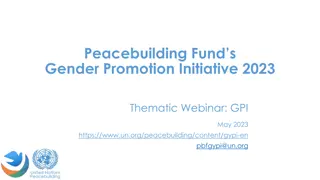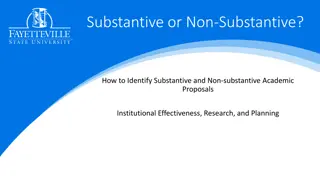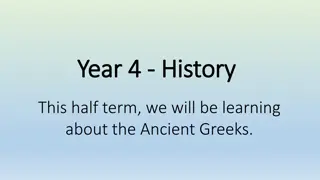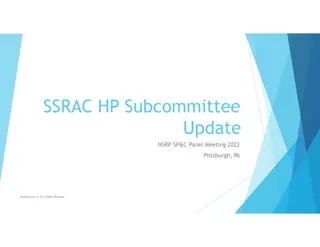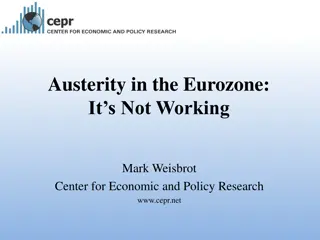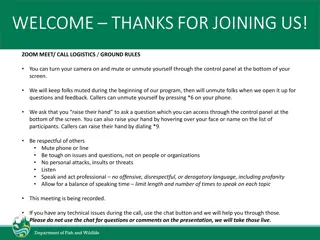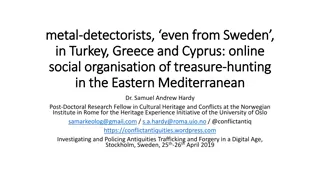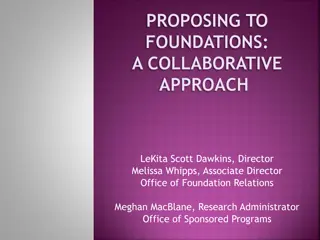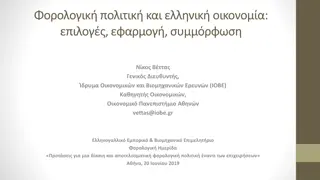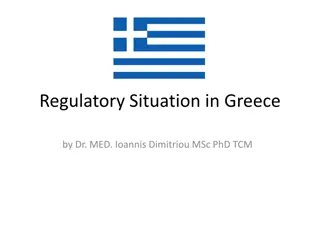
Social Innovation Ecosystem Development in Greece: Approaches and Proposals
Explore the SEED project in Greece focusing on social innovation ecosystem development, competence centers design, and implementation. Funded by the European Union, this initiative aims to address societal challenges through innovation. Discover the key tasks, main references, and the process of social innovation involved in this project.
Download Presentation

Please find below an Image/Link to download the presentation.
The content on the website is provided AS IS for your information and personal use only. It may not be sold, licensed, or shared on other websites without obtaining consent from the author. If you encounter any issues during the download, it is possible that the publisher has removed the file from their server.
You are allowed to download the files provided on this website for personal or commercial use, subject to the condition that they are used lawfully. All files are the property of their respective owners.
The content on the website is provided AS IS for your information and personal use only. It may not be sold, licensed, or shared on other websites without obtaining consent from the author.
E N D
Presentation Transcript
SEED Social innovation EcosystEm Development WP2 SEED Competence centers design and implementation Greece Approaches and Proposals Meeting Sept 8th 2021 Project funded by the European Union Programme for Employment and Social Innovation (EaSI) and the European Social Fund 1
WP2 WP2 2.1./2.2./2.5/2.4. By the GREEK SOCIAL INNOVATION LAB
Task 2.1 SEED competence centers Task 2.1 SEED competence centers codesign codesign Lead partner: Municipality of Turin; co-leads: Politecnico di Milano and FGB M4-24
Main references: As described in the Open Book of Social Innovation https://www.nesta.org.uk/report/the-open-book-of-social- innovation/ As described in the Social Innovation research, A new stage in analysis? https://www.researchgate.net/publication/305387067_Social_innova tion_research_A_new_stage_in_innovation_analysis As described in the Making things happen, Social Innovation and Design , Ezio Manzini 2014 https://direct.mit.edu/desi/article/30/1/57/69137/Making-Things- Happen-Social-Innovation-and-Design
The process of social innovation (Open Book of Social Innovation)
1. Prompts, inspirations and diagnosis factors which highlight the need for innovation such as crisis, public spending cuts, poor performance, strategy as well as the inspirations which spark it, from creative imagination to new evidence. This stage involves diagnosing the problem and framing the question in such a way that the root causes of the problem, not just its symptoms, will be tackled, Going beyond symptoms to identifying the causes of a particular problem SOCIETY Knowledge on gaps, problems, challenges, etc.
2. Proposals and ideas This can involve formal methods such as design or creativity methods to widen the menu of options available. interaction with users promotion of creativity SOCIETY ***Stakeholder mapping case-by- case*** Private sector Public sector Of solutions, ideas, inspirations
3. Prototyping, pilots and trials Users and influencers ideas get tested in practice through simply trying things out, or through more formal pilots, prototypes and randomised controlled trials. Refining and testing ideas is particularly important in the social economy because it s through iteration, and trial and error, that coalitions gather strength (for example, linking users to professionals) and conflicts are resolved (including battles with entrenched interests). It s also through these processes that measures of success come to be agreed upon Private sector Public sector Third sector Raising awareness, etc. Funding, etc. Role of policy Role of society Refining of SI
4. Sustaining Definition of the governance type/system (selection of right stakeholders case-by-case) the organisational form / model the business model the governance type: in some cases a private-based solution light work better whereas in others a community-based initiative may be preferable. Different options case-by-case. Again here the selection of the right stakeholders to mobilise is key. The role of policy here is significant to provide the favourable context of building the SI business case and of thinking of adopting certain solutions that seem to be working. Private sector Public sector Third sector Definition of org model Definition of business model Training, etc. Raising awareness Institutional changes, etc. Funding Role of policy Role of society Sustaining of SI
5. Scaling out and diffusion A range of strategies for growing and spreading an innovation from organisational growth, through licensing and franchising to federations and looser diffusion. Demand matters as much as supply: how market demand, or demand from commissioners and policymakers is mobilised to spread a successful new model. Scaling is a concept from the mass production age, and innovations take hold in the social economy in many other ways, whether through inspiration and emulation, or through the provision of support and know-how from one to another in a more organic and adaptive kind of growth (=> scaling out) (Competence Centre) support for scaling out of SI Raising awareness Reforms, regulations Training, etc. Funding Role of policy Role of society Diffusing demand actions, Promotion Scaling out of SI
6. Systemic change as a result of the CC and many other factors A phenomenon to be studied retrospectively Systemic change usually involves the interaction of many elements: social movements, business models, laws and regulations, data and infrastructures, and entirely new ways of thinking and doing, new frameworks or architectures made up of many smaller innovations. Social innovations commonly come up against the barriers and hostility of an old order and often depend on the creation of new conditions to make the innovations economically viable. These conditions include new technologies, supply chains, institutional forms, skills, and regulatory and fiscal frameworks. Systemic innovation commonly involves changes in the public sector, private sector, grant economy and household sector, usually over long periods of time
SEED Social innovation EcosystEm Development Task 2.2 Social Innovation Implemention methodologies Meeting Project funded by the European Union Programme for Employment and Social Innovation (EaSI) and the European Social Fund 13
2.2. Greek Approach G.S.I.L. examines the existing implementation methodologies, but at the same time practicing interdisciplinary and interoperability exercises methodological benchmarking utilizing positive characteristics of other methodologies also which have been distinguished at a global and European level such as the Greek Labour Market Diagnosis Mechanism. Will also exploit existing and intelligent data classification systems such as ESCO for skills and occupations. very successful practices of highlighting problems, problematic situations and solutions will be used, precisely because innovation is the dominant and fundamental dimension through hackathons, coworking spaces, community accelerator programmes virtual trainers, tutors, open challenge days, study visits, etc). The accumulated experience from the participation of its executives in other parallel innovation schemes at European level such as DIH s (Digital Innovation Hubs) - an EU innovation funding vehicle as well- or the Centres of Excellence, will also be utilized.
WP 2 Task 2.5 Digital Toolbox
Website Structure 1. Home Base a. What is Social Innovation b. Target group c. What is Greek Social Innovation Lab d. What is Competence Center 2. Impact Areas a. Social Innovation Fields page b. Create your own team (register) c. Check your Social Fitness 3. Social innovation groups a. Create a new Social Innovation team b. Join an existing social innovation group c. Digital Democracy Rooms 4. Social innovation actions a. Digital mapping b. Actions that have ended c. Actions you can participate in 5. Learning Toolbox a. Courses Filters b. Lesson 1 c. Lesson 2 6. News page a. Filters for Impact Area, Target group, category, etc b. Post 1 c. Post 2
Home Base Main moto We Co-Create the Ecosystem of Social Innovation What is Social Innovation Definition of social innovation Button: See the Impact Areas (lead to Impact Areas page) Is this for me (Target group) Target group : Social Innovators /Potential Social Innovators/ Political Scientist & Researchers / Public Sector / General Public (Project Reviewer) What is Greek Social Innovation Lab A short description of GSIL Link/button that leads to new page What is Competence Center A short description of Competence center Button: learn more (lead to Competence Center page)
Impact Areas 1. Social Innovation Fields page a. Digital b. Social c. Green 2. Create your own team (register) + small description why to click on those a. Button: Join the National Social Innovation Ecosystem (lead to registration page) b. Button: See social innovation groups (lead to Social innovation groups page) 1. Check your Social Fitness Self Assessment test (for the registered users it will show recommendations on CC but for those who have not registered they will have only the results) Exapmle
Social innovation groups Create a new Social Innovation team Do you want to create a new team? Button: See here how (lead to Register page) Join an existing social innovation group Do you want to join an existing team? Button: "See the existing teams" (List of existing groups & the actions they have implemented) Digital Democracy Rooms ... ...

